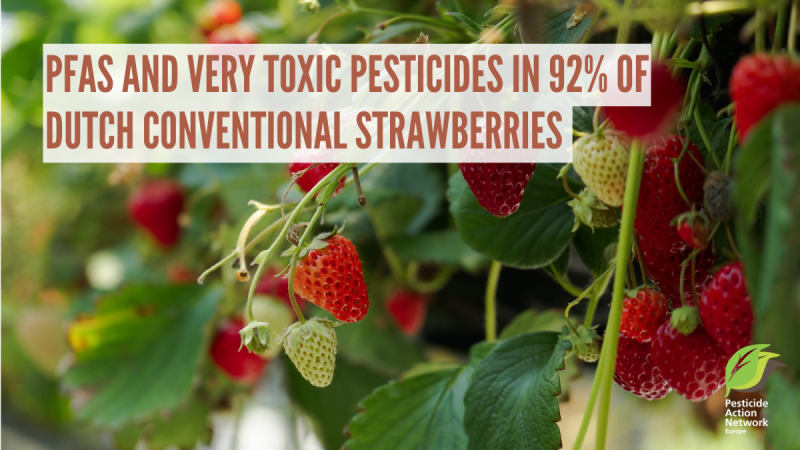Most conventional strawberries are not suitable for children. That is concluded by PAN Netherlands after testing 15 samples for pesticides. One to three different PFAS pesticides were present on 69% of the strawberries. Almost half contained residues of pesticides that are so toxic that they should have already been banned long ago. The only two pesticide-free samples were organic. The rest had an average of 3 pesticides.
Strawberries are notorious for cocktails of pesticides. Pesticide Action Network Netherlands sampled the fruit in 2021 and 2022. They repeated the tests for pesticides in 2024 in 15 trays of strawberries from 15 Dutch supermarkets, among them two organic shops. Only the organic strawberries were clean from pesticides. In the other samples, they found 12 different pesticides, an average of 3.0 different substances per tray. In 2021 and 2022 the average was 3.5 and 3.7 so it seems to be decreasing slightly.
However, they did find some particularly harmful substances in almost all samples: there were 1 to 3 different PFAS pesticides on 69% of the common strawberries surveyed. And 46% of the common strawberries were contaminated with highly toxic 'Candidates for Substitution'.
European legislators identify these CfS substances to be poorly degradable and/or so toxic that member states must replace them with safer alternatives wherever possible. Since 2015, the Netherlands has also been obliged to do so, but no replacement took place.
PFAS pesticides combine intrinsic toxic properties to target pests with carbon-fluorine bonds that do not normally exist in nature. They are persistent themselves or they break down to very persistent TFA. This small PFAS has been found to contaminate our water resources and our drinking water.
"This must change now," said Margriet Mantingh, president of PAN-NL. "We need to stop PFAS pesticides soon. These substances break down very poorly and cause damage to our health and environment."
Only one of the conventional strawberry samples did not contain PFAS or other highly toxic pesticides. Remarkable, this grower shows it can be done.
One sample had residues that exceeded the individual maximum residue limits (MRL) in strawberries. Here it’s important to highlight there is yet no safety standard for dietary exposure to mixtures of pesticides, despite the legal obligation since 2005 to address this issue. This survey shows that consumers can be exposed to mixtures of pesticides by eating strawberries, the cumulative risk of which is unknown.
Only organic strawberries meet the standard for baby and toddler food
None of the strawberries grown with pesticides investigated meet the maximum permissible levels of pesticide residues for baby and toddler food of 0.01 mg/kg. The summed norm exceedance ranges from 12 to 120 times the limit. Only the two organic trays of strawberries meet this standard.
PAN Netherlands strongly advises consumers, especially vulnerable groups, pregnant women and families to try buying strawberries (and other foodstuffs) grown without chemical pesticides for babies, toddlers and children.
Read more: Aardbeien-2024: PFAS-pesticiden en KvV (in Dutch)
